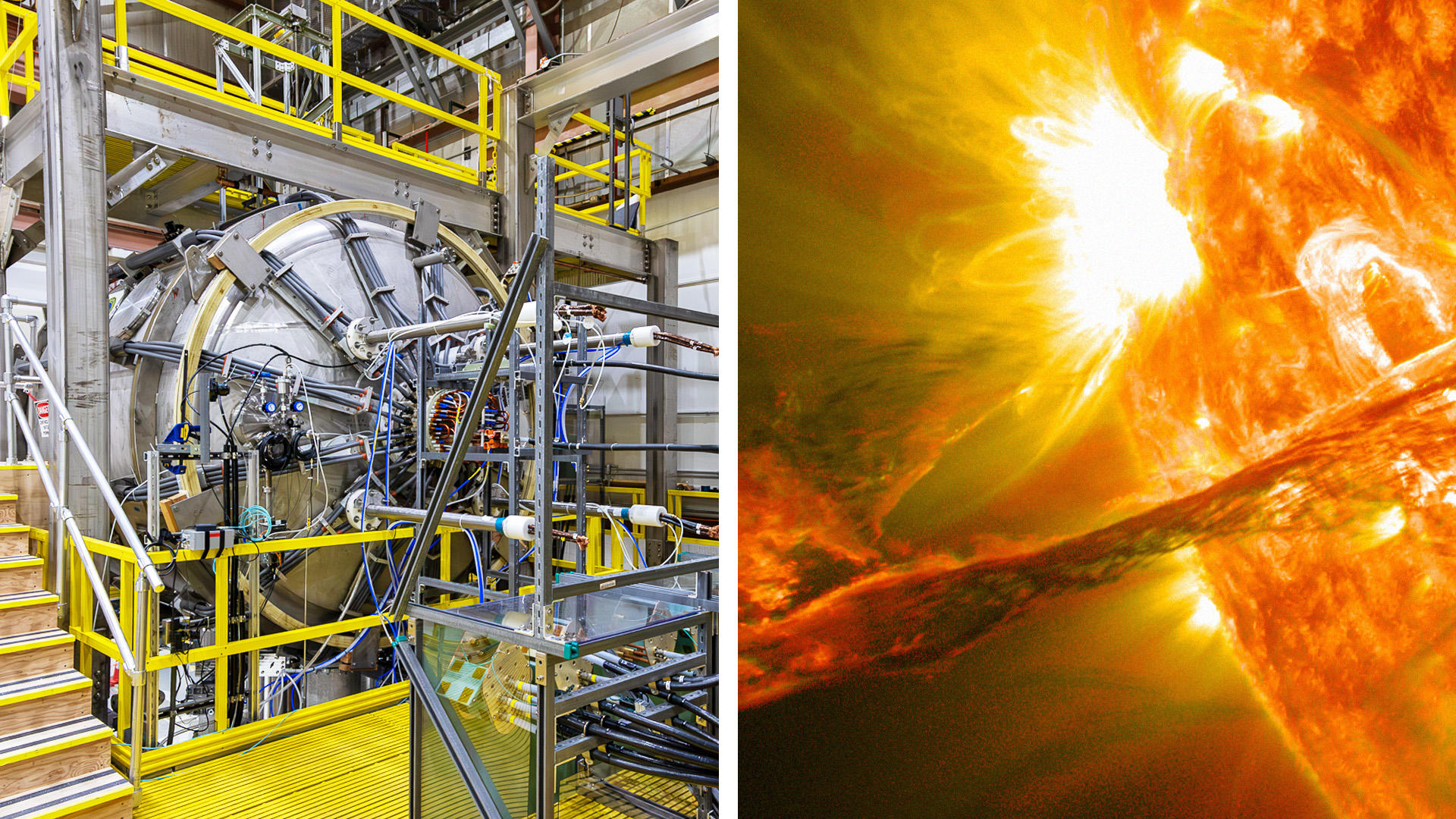The Facility for Laboratory Reconnection Experiments (FLARE), recently unveiled at Princeton Plasma Physics Laboratory (PPPL), brings the dramatic power of solar flares and fusion reactions into the laboratory.
As a groundbreaking research platform, FLARE is set to transform how scientists study magnetic reconnection, a process at the heart of some of the universe's most energetic phenomena.

Image Credit PPPL: On the left, FLARE ready for operations. On the right, an image of a solar flare. (Photo credits: Michael Livingston / PPPL Communications Department; NASA Goddard Institute for Space Studies)
FLARE’s Distinctive Capabilities
FLARE isn’t just big, it’s a leap forward in experimental science. Stretching 12 feet long, 9 feet in diameter, and weighing more than 10 tons, this robust device allows researchers to observe magnetic reconnection under tightly controlled conditions.
Magnetic field lines that snap and realign release vast energy, driving solar flares and complicating fusion experiments. Understanding this process is vital for both astrophysics and energy innovation.
- Real-world simulation: FLARE authentically replicates magnetic reconnection as it occurs in nature, something previous machines couldn’t achieve.
- International collaboration: Researchers worldwide can propose and conduct experiments, working directly with experts at PPPL.
- Direct diagnostics: Unlike spacecraft or virtual models, FLARE enables precise, real-time measurements of plasma during reconnection events.
Why Magnetic Reconnection Matters
Studying magnetic reconnection has tangible impacts. Solar flares triggered by this process can send waves of charged particles toward Earth, threatening satellites, navigation systems, and power grids.
In fusion reactors, reconnection can abruptly halt energy-producing reactions. By unlocking the secrets of these events, FLARE could help protect our technological infrastructure and advance the pursuit of clean fusion energy.
- Protecting technology: Insights from FLARE may guide engineers in making systems more resilient to space weather.
- Enhancing fusion: A better grasp of reconnection will support more stable, efficient fusion devices.
Engineering Breakthroughs
FLARE can unleash over 6 million joules of energy per experiment, that's enough to power a thousand homes for five seconds! This immense energy allows scientists to create plasma conditions mimicking those found in stars and fusion machines.
Unlike space probes, which sample only small areas, or computer models, which may miss critical details, FLARE provides a comprehensive view. Its high-resolution measurements let researchers capture the intricacies of plasma behavior, offering data rich enough to solve longstanding mysteries.
Tackling Big Questions
One of FLARE’s main research goals is to determine if magnetic reconnection happens simultaneously at multiple sites, a phenomenon suspected in vast cosmic environments but never directly observed in the lab. Proving this could fundamentally change how we understand energy bursts in solar and stellar flares.
Professor Hantao Ji, principal investigator for FLARE, emphasizes that this work "goes beyond what is currently available," leveraging laboratory strengths to answer questions that spacecraft and simulations cannot. While the collaborative approach means scientists everywhere can contribute new ideas and refine experimental techniques alongside PPPL teams.
A Hub for Innovation
FLARE is more than a scientific instrument; it’s a model for global collaboration. By welcoming external researchers, FLARE is poised to become a nexus for innovation in plasma physics, accelerating progress and strengthening ties across the international community.
With the launch of FLARE, PPPL reaffirms its leadership in plasma science and fusion research. This remarkable device bridges the gap between cosmic events and laboratory study, promising insights that will deepen our understanding of the universe and bolster our technological resilience.
Source: Princeton Plasma Physics Laboratory, Unprecedented new device at PPPL will help to unravel the mysteries of the universe

PPPL FLARE Device Is Revolutionizing Plasma Physics Research